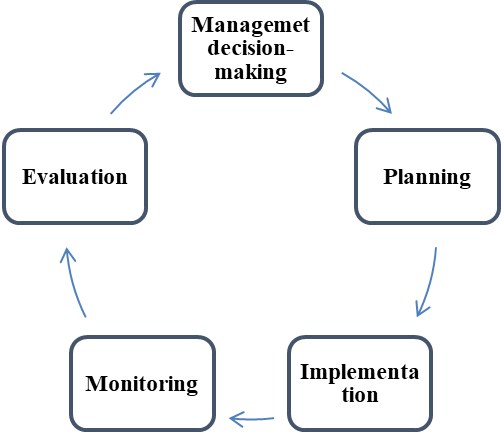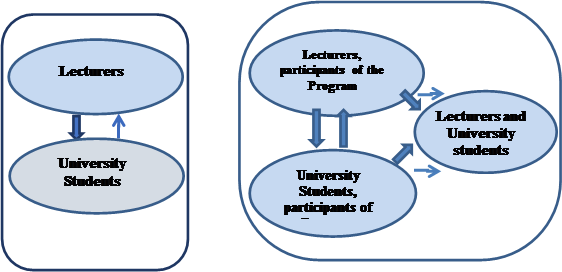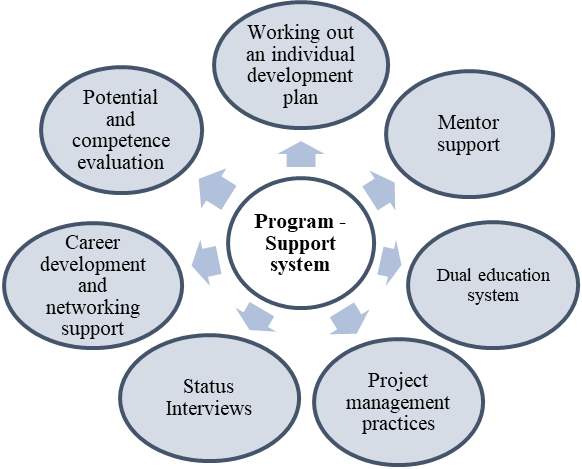Abstract
The evaluation of high potential children social support is a difficult matter. The managers are inclined to invest only in the programs they consider effective. This study investigates the social program monitoring as a system. The Republic of Tatarstan (Russia) implements the integrated system of high potential children identification, support and mentoring. This program is carried out by an Autonomous non-commercial organization “Kazan Open University of Talents. The monitoring goal is to determine how available the measures of the high potential children and adolescents support are. This study highlights the stages of the systematic approach approbation. They include: analyzing the evaluated program as a system; defining the hierarchical levels of the interacting systems and subsystems; describing the social program influence on the elements of the system. A separate thesis exemplifies defining the qualitative indicators. The results of the study and the analysis of the monitoring process allowed exposing several disadvantages in the monitoring system of the high potential children (further on ‘HP children’) support. The distinguished disadvantages made it possible to develop the perspective changes in the monitoring procedure. For example, it was determined that at the stage of the developing the instruments, it is vital to split the program participants into groups of those who enter the HP support program and those who are not a part of it. It helps to distinguish the bearers of the formed abilities and in its turn contributes to improving the control and management of the investigated social processes.
Keywords: Systematic approachmonitoring and evaluationSocial Programmonitoring indicators
Introduction
Social politics projects and programs require evidence of their efficient performance in the country. That is done not only for the social politics reports but also for the grounded future decisions as well as development of the norms and standards.
Any activity demands analysis and critical consideration of the people who perform it. One of the most important aspects of monitoring in the social sphere is feedback (Plotnick & Kennedy, 2018; Parkhill, Deans, & Chapin, 2018). Monitoring of the planned activity is realized in its process, though its evaluation can be carried out at the end of some particular period or when finishing the whole program. Both monitoring and evaluation guarantee the control of the process. Management decisions about the necessary changes and modifying the plans are made on the basis of the monitoring and evaluation data.

M. Kulemin defines the term ‘monitoring’ as follows: “Monitoring is a system of collecting, processing, storing and distributing information about any system or its elements that is aimed at informational management of that system that allows constantly evaluating its condition and predicting its development” (Kulemin, 2001).
Problem Statement
Social politics, projects and programs efficiency is of great concern of the government in most countries of the world. The investigations of such kind are usually reflected in numerous reports and influences management decisions. Performance efficiency in the social sphere involves evaluation and monitoring procedures. The data in this sphere are usually voluminous and varied, thus, it results in monitoring difficulties and demands a systematic approach to the analysis procedure and data evaluation. American (Lerner, Richard, Galambos, & Nancy, 2012; Robinson, Clinkenbeard, & Pamela 1998) European (Antequera-Manotas, & Cortés-Peña, 2016; Chessor, 2016; Jonathan & Huefner, 2018) and Russian scientists (Principles of program and politics evaluation, 2017) worked out the principles and requirements to the procedures of evaluation and monitoring in the social sphere. However, the efficiency evaluation of the monitoring itself is still disputable and demands being worked through in terms of its effective procedure models and corresponding events. Little research considers implementation of real practices of social programs monitoring models.
Research Questions
The Government of Tatarstan Rupublic (Russia) developed the Program of identification, developing and mentoring HP children and adolescents. This program is realized by an Autonomous non-commercial organization “Kazan Open University 2.0” (University of talents, 2018). This integrated system of the HP children and adolescents support is based on “The adolescent intellect and creativity development concept in the Republic of Tatarstan “Perspektiva” (that in its turn is worked out using the National system of detecting and developing the young with high potential in the Russian Federation) (Concept of the young talented detection and support National system, 2012), and “The State program “Strategic management of the high-potential children in the Republic of Tatarstan for 2015-2020”. The least initiative is that of the Tatarstan President R.N. Minnihanov.
One of the most important goals of Tatarstan HP children support system is developing the monitoring system in the Republic (further on ‘the Researched Program’ or ‘the Program’). The goal of the monitoring is to analyze the accessibility of the state HP children support measures and available conditions of their self-realization in Tatarstan.
The monitoring goals are:
to develop the criteria and a model of evaluating the efficiency of HP children support measures and conditions of their self-realization in Tatarstan;
to detect whether the goals and methods of HP children support are properly understood by their key stakeholders such as mentors, employers, parents and HP young. Besides, the stakeholders’ involvement in the HP support system is also important for the future of Tatarstan;
to determine the degree of the municipalities involvement into the program;
to evaluate whether the HP adolescents’ needs, preferences and inclinations meet the requirements of the stakeholders and vice versa;
to find out if the actual needs and interests of the HP adolescents meet the leading directions of the State Program;
to determine possible ways of integration of the HP children into the economy of Tatarstan;
to work out recommendation for stakeholders and foresee possible changes in the approach, events and instruments of implementation of the State Program in the future.
To sum up, it is vital to develop a monitoring system of the State Program to be able to evaluate its effect at a higher hierarchical level – the State program of Tatarstan as well as its influence on the social environment. Such goal demands a systematic approach to describing and evaluating the HP children support system in Tatarstan.
Purpose of the Study
The purpose of this study is to develop a model of monitoring the social program that deals with the HP children support and apply a systematic approach to it in the Republic of Tatarstan (Russia).
Research Methods
The methods of the study include description of the monitored Program as a system and developing the monitoring model. The description will serve as a basis for the received data. The model is supposed to reflect the reaction of any influenced element in the described system as well as other interrelated elements of it. This gives a detailed picture of the way the system of the HP children and adolescents works (Kosheleva, 2010).
The description of the Program effect may reflect: actions or events, the expected results of every action, and the sources involved (Holodnya, 2011; Zinovieva, 2018). The results are presented in two aspects:
On the one hand, it is important to detect what actions and events result in achieving the goal of the Program that is knowledge and experience.
On the other hand, it is clear from the Program contents what knowledge and experience should be formed.
This model of description allows seeing that the result of one action serves a sourсe for the other one. Besides it helps to understand which actions form the HP groups and which lead to knowledge and experience.
Findings
The Program contributed to differentiating the students who have taken part in its events and those who have not. That serves as a new feedback mechanism.
For instance, many young men who take part in the Program events propose their teachers and monitors to take up new projects. Thus, firstly, this process promotes the social projects development in the region the young live in or in their educational establishment that cooperates with the investigated Program. Secondly, the successful social projecting experience leads to enlarging the number of the project participants. So the involvement in the social project increases.
Thus, it is supposed that the young do not differ in their education level or personal qualities. The main difference lies in their social background, i.e. the systems or projects they are a part of. For example, a young man who worked on a significant social project received great support from the Principal of his Institution. The other young man was backed by a technical expert, a friend of his, with the sources and technical part of the project. But if a young man has no ties or support from the experts, his project cannot be carried out.
The initialThe current
state of the Systemstate of the System

The Systematic approach assumes the investigation of the subject as a system and taking the system requirements in the monitoring process. For instance, the system requirements is applied when developing the monitoring model and defining the features that reflect the efficiency of the Program/ project implementation.

The Russian association of specialists in the program and policy evaluation (
developing evaluation indicators and giving their definitions;
defining the data sources;
choosing the data acquisition methods;
determining the data frequency and schedule of data acquisition.
One of the most difficult tasks in monitoring is to choose the evaluation criteria on the basis a great number of indicators. Sometimes the data seem contradictory that results in a new goal to make the data reliable. The goal and objectives of the programme are scarecely transferred into indicators which are to be represented in terms of quantity (Kuzmin, Sallivan, & Kosheleva, 2009).
Thus, the Monitoring model was developed taking into account the system of the support, developing and mentoring of the HP children and adolescents.

The above-mentioned components of the monitoring model were developed to evaluate its efficiency. Every component is evaluated in accordance with several indicators.
For example, the component ‘Potential and competence evaluation’ is measured according to the following indicators:
the arithmetic average of the number of evaluation instruments that the mentors and teachers use;
the percentage of the respondents who make use of special evaluation instruments out of the total number of respondents.
Different indicators were used when evaluating ‘Dual education practice, professional probes and in-depth training’. They included:
the percentage of the dual education practices and professional probes mentioned in the questionnaire out of the total number of responses;
the number of the respondents pointing at the existing problems in the system of dual education;
the number of the problems mentioned.
Evaluating the component ‘Mentor support’ involved the following indicators:
the percentage of the children who attend clubs and societies organized by a mentor;
the percentage of children and parents who mention mentors in their questionnaire.
The survey was carried out on the questionnaire data of the four groups of the respondents: school children and the young, mentors and the Heads of the municipalities. The questionaire for these target groups served a means of collecting the data. The questionaires were fulfilled by the investigated groups online or during the events, master-classes, forums and camps organised as a part of the HP children support Program.
Conclusion
The implemented monitoring model that was developed in the systematic approach made it possible to make the following conclusions:
the systematic approach helps to prove the formation of groups – bearers of the knowledge and experience transmitted by the investigated Program,
a single monitoring can not serve the long-term prognosis,
the monitoring model should be improved in terms of:
developing the criteria for evaluating the monitoring results as a system product;
defining the indicators more thoroughly so that they could serve the elements of the data analisys when the operators deal with great amounts of information;
distinguishing between the respondents who are a part of the Program and those who are not at the stage of the questionaire development.
To sum up, the suggested systematic approach makes it possible to trace the investigated objects at different levels of the system operation. It also helped to improve the monitoring and evaluation system as well as to make the prognosing, control and management of the investigated systems more effective.
Acknowledgments
The research was funded by an Autonomous non-commercial organization “Kazan Open University of Talents 2.0”, Kazan, Russia.
References
- Antequera-Manotas, E., Cortés-Peña, O. (2016). Problems, challenges, trends and prospects for Special Education for talented children, European Proceedings of Social & Behavioural Sciences. Retrieved from http://www.futureacademy.org.uk/files/images/upload/88_4593_7225_fullText_1_28.pdf. doi: 10.15405/epsbs.2016.11.88
- Chessor, D. (2016). The Impact of Grouping Gifted Students on Motivation, Future Academy. doi: 10.15405/ejsbs.117
- Jonathan, J., Huefner, (2018). Crosswalk of published quality standards for residential care for children and adolescents, Children and Youth Services Review: Vol. 88 (pp. 490-496).
- Concept of the young talented detection and support National system (2012). Order of the Russian Federation President, 210. 2011-04-07.
- Holodnaya, M.A. (2011). The evolution of the intellectual giftedness: from childhood to adultery. Development inversion effect. Psychological Journal, vol.32, 5 (pp. 69-78).
- Kosheleva, N. (2010). Systematic approach to programs evaluation. Process Consulting company. Retrieved from http://processconsulting.ru/img/all/7_Kosheleva_System_thinking_2010.pdf [Accessed 2010-03-25].
- Kuzmin, A.I., Sallivan, O., Kosheleva, N.A. (2009). Program evaluation. “Prosto-RK” publishing (pp.88-98).
- Kulemin, N.A. (2001).Qualimetric monitoring in education system, Pedagogics, 3 (pp. 16-30).
- Lerner, Richard M., Galambos, Nancy L. (2012). Adolescent development: challenges and opportunities for research, programs, policies. Annual review of psychology, vol.49 (pp. 413-446). Retrieved from https://www.annualreviews.org/doi/full/10.1146/annurev.psych.49.1.413
- Parkhill, A, Deans, C.L, Chapin L.A. (2018). Pre-leadership processes in leadership training for adolescents, Children and Youth Services Review: Vol. 88 (pp. 375-379).
- Principles of programs ands politics evaluation (2017). Adopted by the Russian association of the specialists in programs and politics evaluation on 2017-01-16. Retrieved from http://eval.ru/attach_files/file_menu_78.pdf [Accessed 2018-03-25].
- Plotnick, R. D., Kennedy, A. I. (2018). How accurate are imputed child support orders? Retrieved from https://doi.org/10.1016/j.childyouth.2018.03.049
- Robinson, A., Clinkenbeard, Pamela R. (1998). Giftedness: An Exceptionality examined, Annual review of psychology, vol.49 (pp. 117-139). Retrieved from https://www.annualreviews.org/doi/full/10.1146/annurev.psych.49.1.117#_i20
- State program “Strategic management of the talents in the Republic of Tatarstan for 2015-2020”.
- Retrieved from http://www.gossov.tatarstan.ru/fs/a_events/2781_fieldfullim/merged%201.pdf [Accessed 2010-03-25].
- The concept of developing and implementation of the children and adolescents intellectual and creative
- development ‘Perspektiva’ (2015). Retrieved from http://www.kpfu.ru›docs/F363465792/la_s_16841.pdf [Accessed 2017-03-25].
- University of talents (2018). Retrieved from https://utalents.ru/docs [Accessed 2018-02-25].
- Zinovieva, V.I. (2018). The Experience of Social Support Activity in the Technical University, European Proceedings of Social and Behavioural Sciences. Retrieved from http://www.futureacademy.org.uk/files/images/upload/WELLSO2017F053.pdf. doi: http://dx.doi.org/10.15405/epsbs.2018.04.53
Copyright information

This work is licensed under a Creative Commons Attribution-NonCommercial-NoDerivatives 4.0 International License.
About this article
Publication Date
17 December 2018
Article Doi
eBook ISBN
978-1-80296-049-5
Publisher
Future Academy
Volume
50
Print ISBN (optional)
-
Edition Number
1st Edition
Pages
1-1464
Subjects
Social sciences, modern society,innovation, social science and technology, organizational behaviour, organizational theory
Cite this article as:
Safonova, N., Potanina, A., & Sinichkina, A. (2018). Systematic Approach To Evaluating High Potential Children Support Program In Tatarstan (Russia). In I. B. Ardashkin, B. Vladimir Iosifovich, & N. V. Martyushev (Eds.), Research Paradigms Transformation in Social Sciences, vol 50. European Proceedings of Social and Behavioural Sciences (pp. 1019-1026). Future Academy. https://doi.org/10.15405/epsbs.2018.12.125

